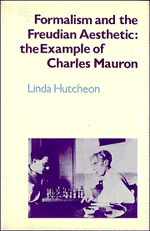Book contents
- Frontmatter
- Contents
- Preface
- Acknowledgments
- Introduction
- Part I The critical formation: science, formalism, and aesthetic contemplation
- 1 Early roots: science, Bloomsbury, and Roger Fry
- 2 The attraction of formalism
- 3 Art and science
- 4 Toward psychocritique: from “spiritual” to “psychological”
- Part II Psychoanalysis and literary criticism
- Conclusion
- Appendices
- Notes
- Index
2 - The attraction of formalism
Published online by Cambridge University Press: 12 January 2010
- Frontmatter
- Contents
- Preface
- Acknowledgments
- Introduction
- Part I The critical formation: science, formalism, and aesthetic contemplation
- 1 Early roots: science, Bloomsbury, and Roger Fry
- 2 The attraction of formalism
- 3 Art and science
- 4 Toward psychocritique: from “spiritual” to “psychological”
- Part II Psychoanalysis and literary criticism
- Conclusion
- Appendices
- Notes
- Index
Summary
… the design itself, the scaffolding of the architectonic structure, is really what counts.
roger fryCHARLES MAURON was himself like the disinterested scientist he described as believing that the human mind could conceive clearly nothing but relations and systems of relations (1930a: 24). And it was as a man of science that Mauron was attracted to formalism. For Roger Fry, both aesthetic contemplation and scientific reasoning involved the disinterested contemplation of what he too called “inevitable relations.” Although Mauron later disagreed with Fry's contemplative conception of science, all of his writings manifest the same belief in the importance of what Fry variously called form, design, unity of texture, rhythm, and structural harmony. Fry came to see art primarily as a system and, where the system was found wanting in coherence or control, the art was found wanting in quality. The sense of ordered design, of deliberate coordination of elements was what he appreciated in the postimpressionists, who, he argued, had succeeded in rediscovering the principles of structural design lost by the impressionists. The true artist, Fry believed, was ultimately and, in the long run, exclusively concerned with form.
Fry's meeting with Mauron coincided with what Quentin Bell has called the period of Fry's life in which he was most deeply concerned with “plastic values.” Concomitant with this concern was his attraction to the idea of aesthetic “purity.”
- Type
- Chapter
- Information
- Formalism and the Freudian AestheticThe Example of Charles Mauron, pp. 35 - 51Publisher: Cambridge University PressPrint publication year: 1984



